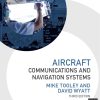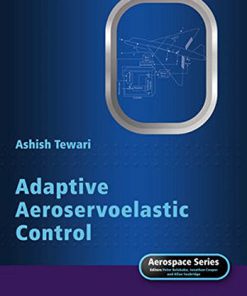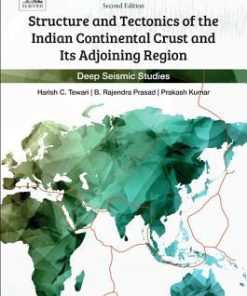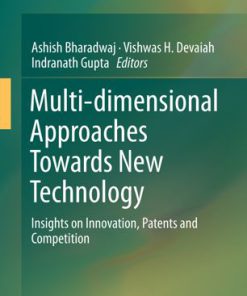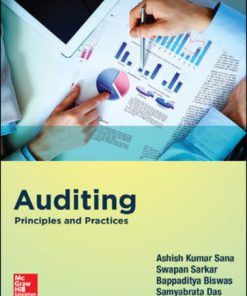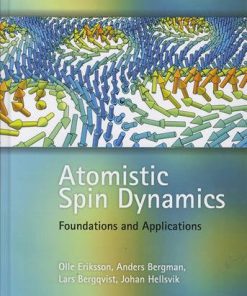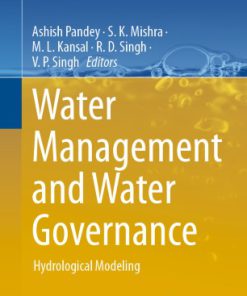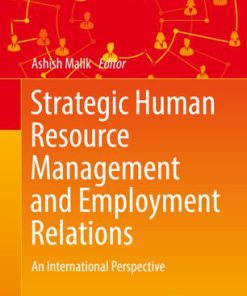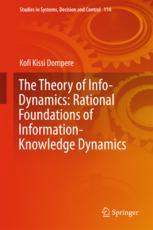Foundations of Space Dynamics 1st Edition by Ashish Tewari ISBN 1119455349 9781119455349
$50.00 Original price was: $50.00.$25.00Current price is: $25.00.
Foundations of Space Dynamics 1st Edition by Ashish Tewari – Ebook PDF Instant Download/Delivery: 1119455349, 978-1119455349
Full dowload Foundations of Space Dynamics 1st Edition after payment
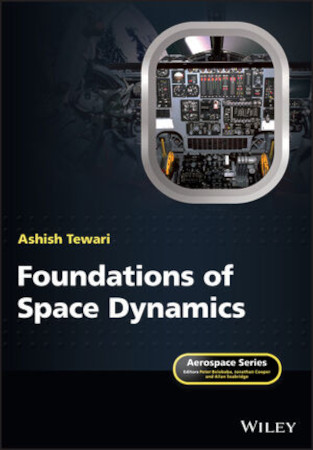
Product details:
ISBN 10: 1119455349
ISBN 13: 978-1119455349
Author: Ashish Tewari
An introduction to orbital mechanics and spacecraft attitude dynamics
Foundations of Space Dynamics offers an authoritative text that combines a comprehensive review of both orbital mechanics and dynamics. The author a noted expert in the field covers up-to-date topics including: orbital perturbations, Lambert’s transfer, formation flying, and gravity-gradient stabilization. The text provides an introduction to space dynamics in its entirety, including important analytical derivations and practical space flight examples.
Written in an accessible and concise style, Foundations of Space Dynamics highlights analytical development and rigor, rather than numerical solutions via ready-made computer codes. To enhance learning, the book is filled with helpful tables, figures, exercises, and solved examples.
This important book:
- Covers space dynamics with a systematic and comprehensive approach
- Is designed to be a practical text filled with real-world examples
- Contains information on the most current applications
- Includes up-to-date topics from orbital perturbations to gravity- gradient stabilization
- Offers a deep understanding of space dynamics often lacking in other textbooks
Written for undergraduate and graduate students and professionals in aerospace engineering, Foundations of Space Dynamics offers an introduction to the most current information on orbital mechanics and dynamics.
Foundations of Space Dynamics 1st Table of contents:
1. Introduction
- 1.1 Space Flight
- 1.1.1 Atmosphere as Perturbing Environment
- 1.1.2 Gravity as the Governing Force
- 1.1.3 Topics in Space Dynamics
- 1.2 Reference Frames and Time Scales
- 1.2.1 Sidereal Frame
- 1.2.2 Celestial Frame
- 1.2.3 Synodic Frame
- 1.2.4 Julian Date
- 1.3 Classification of Space Missions
- Exercises
- References
2. Dynamics
- 2.1 Notation and Basics
- 2.2 Plane Kinematics
- 2.3 Newton’s Laws
- 2.4 Particle Dynamics
- 2.5 The n-Body Problem
- 2.6 Dynamics of a Body
- 2.7 Gravity Field of a Body
- 2.7.1 Legendre Polynomials
- 2.7.2 Spherical Coordinates
- 2.7.3 Axisymmetric Body
- 2.7.4 Spherical Body with Radially Symmetric Mass Distribution
- Exercises
- References
3. Keplerian Motion
- 3.1 The Two-Body Problem
- 3.2 Orbital Angular Momentum
- 3.3 Orbital Energy Integral
- 3.4 Orbital Eccentricity
- 3.5 Orbit Equation
- 3.5.1 Elliptic Orbit
- 3.5.2 Parabolic Orbit
- 3.5.3 Hyperbolic Orbit
- 3.5.4 Rectilinear Motion
- 3.6 Orbital Velocity and Flight Path Angle
- 3.7 Perifocal Frame and Lagrange’s Coefficients
- Exercises
4. Time in Orbit
- 4.1 Position and Velocity in an Elliptic Orbit
- 4.2 Solution to Kepler’s Equation
- 4.2.1 Newton’s Method
- 4.2.2 Solution by Bessel Functions
- 4.3 Position and Velocity in a Hyperbolic Orbit
- 4.4 Position and Velocity in a Parabolic Orbit
- 4.5 Universal Variable for Keplerian Motion
- Exercises
- References
5. Orbital Plane
- 5.1 Rotation Matrix
- 5.2 Euler Axis and Principal Angle
- 5.3 Elementary Rotations and Euler Angles
- 5.4 Euler-Angle Representation of the Orbital Plane
- 5.4.1 Celestial Reference Frame
- 5.4.2 Local-Horizon Frame
- 5.4.3 Classical Euler Angles
- 5.5 Planet-Fixed Coordinate System
- Exercises
6. Orbital Manoeuvres
- 6.1 Single-Impulse Orbital Manoeuvres
- 6.2 Multi-impulse Orbital Transfer
- 6.2.1 Hohmann Transfer
- 6.2.2 Rendezvous in Circular Orbit
- 6.2.3 Outer Bi-elliptic Transfer
- 6.3 Continuous Thrust Manoeuvres
- 6.3.1 Planar Manoeuvres
- 6.3.2 Constant Radial Acceleration from Circular Orbit
- 6.3.3 Constant Circumferential Acceleration from Circular Orbit
- 6.3.4 Constant Tangential Acceleration from Circular Orbit
- Exercises
- References
7. Relative Motion in Orbit
- 7.1 Hill-Clohessy-Wiltshire Equations
- 7.2 Linear State-Space Model
- 7.3 Impulsive Manoeuvres About a Circular Orbit
- 7.3.1 Orbital Rendezvous
- 7.4 Keplerian Relative Motion
- Exercises
8. Lambert’s Problem
- 8.1 Two-Point Orbital Transfer
- 8.1.1 Transfer Triangle and Terminal Velocity Vectors
- 8.2 Elliptic Transfer
- 8.2.1 Locus of the Vacant Focii
- 8.2.2 Minimum-Energy and Minimum-Eccentricity Transfers
- 8.3 Lambert’s Theorem
- 8.3.1 Time in Elliptic Transfer
- 8.3.2 Time in Hyperbolic Transfer
- 8.3.3 Time in Parabolic Transfer
- 8.4 Solution to Lambert’s Problem
- 8.4.1 Parameter of Transfer Orbit
- 8.4.2 Stumpff Function Method
- 8.4.3 Hypergeometric Function Method
- Exercises
- References
9. Orbital Perturbations
- 9.1 Perturbing Acceleration
- 9.2 Osculating Orbit
- 9.3 Variation of Parameters
- 9.3.1 Lagrange Brackets
- 9.4 Lagrange Planetary Equations
- 9.5 Gauss Variational Model
- 9.6 Variation of Vectors
- 9.7 Mean Orbital Perturbation
- 9.8 Orbital Perturbation Due to Oblateness
- 9.8.1 Sun-Synchronous Orbits
- 9.8.2 Molniya Orbits
- 9.9 Effects of Atmospheric Drag
- 9.9.1 Life of a Satellite in a Low Circular Orbit
- 9.9.2 Effect on Orbital Angular Momentum
- 9.9.3 Effect on Orbital Eccentricity and Periapsis
- 9.10 Third-Body Perturbation
- 9.10.1 Lunar and Solar Perturbations on an Earth Satellite
- 9.10.2 Sphere of Influence and Conic Patching
- 9.11 Numerical Methods for Perturbed Keplerian Motion
- 9.11.1 Cowell’s Method
- 9.11.2 Encke’s Method
- Exercises
- References
10. Three-Body Problem
- 10.1 Equations of Motion
- 10.2 Particular Solutions by Lagrange
- Equilibrium Solutions in a Rotating Frame
- Conic Section Solutions
- 10.3 Circular Restricted Three-Body Problem
- 10.3.1 Equations of Motion in the Inertial Frame
- 10.4 Non-dimensional Equations in the Synodic Frame
- 10.5 Lagrangian Points and Stability
- 10.5.1 Stability Analysis
- 10.6 Orbital Energy and Jacobi’s Integral
- 10.6.1 Zero-Relative-Speed Contours
- 10.6.2 Tisserand’s Criterion
- 10.7 Canonical Formulation
- 10.8 Special Three-Body Trajectories
- 10.8.1 Perturbed Orbits About a Primary
- 10.8.2 Free-Return Trajectories
- Exercises
- References
11. Attitude Dynamics
- 11.1 Euler’s Equations of Attitude Kinetics
- 11.2 Attitude Kinematics
- 11.3 Rotational Kinetic Energy
- 11.4 Principal Axes
- 11.5 Torque-Free Rotation of Spacecraft
- 11.5.1 Stability of Rotational States
- 11.6 Precession and Nutation
- 11.7 Semi-Rigid Spacecraft
- 11.7.1 Dual-Spin Stability
- 11.8 Solution to Torque-Free Euler’s Equations
- 11.8.1 Axisymmetric Spacecraft
- 11.8.2 Jacobian Elliptic Functions
- 11.8.3 Range-Kutta Solution
- 11.9 Gravity-Gradient Stabilization
- Exercises
12. Attitude Manoeuvres
- 12.1 Impulsive Manoeuvres with Attitude Thrusters
- 12.1.1 Single-Axis Rotation
- 12.1.2 Rigid Axisymmetric Spin-Stabilized Spacecraft
- 12.1.3 Spin-Stabilized Asymmetric Spacecraft
- 12.2 Attitude Manoeuvres with Rotors
- 12.2.1 Reaction Wheel
- 12.2.2 Control-Moment Gyro
- 12.2.3 Variable-Speed Control-Moment Gyro
People also search for Foundations of Space Dynamics 1st:
fundamentals of space systems pdf
foundations of astrophysics solutions manual pdf
the foundation of space science is astronomy
building foundations of scientific understanding pdf
space foundation space symposium
You may also like…
Science (General)
Business & Economics
Multi dimensional Approaches Towards New Technology Ashish Bharadwaj
Business & Economics - Accounting
Auditing: Principles and Practices 1st Edition Ashish Kumar Sana
Business & Economics
Strategic Human Resource Management and Employment Relations Ashish Malik
Physics
Introduction to Modern Dynamics: Chaos, Networks, Space, and Time 2nd Edition David D. Nolte


